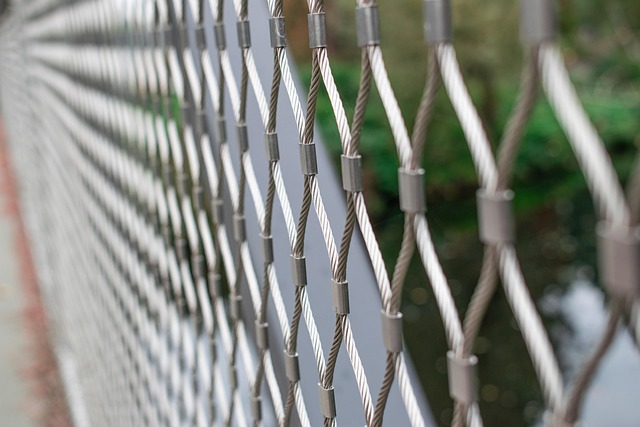In coastal regions, where harsh weather conditions and salt air pose unique challenges, durable wooden fencing is a popular and aesthetically pleasing solution. This article explores how the right type of wood can provide long-lasting protection against corrosion and extreme climates. We’ll delve into the benefits, from enhanced structural integrity to reduced maintenance needs, offering a sustainable and visually appealing alternative for your coastal property. Additionally, we’ll guide you through selecting the ideal wood species, installation best practices, and environmental advantages.
- Understanding Coastal Fencing Challenges
- Advantages of Durable Wooden Fencing
- Choosing the Right Wood Species
- Installation Techniques for Coastline Durability
- Maintenance Tips for Longevity
- Environmental Benefits and Aesthetics
Understanding Coastal Fencing Challenges
Coastal areas present unique challenges when it comes to fencing due to their harsh environments. Salt air, strong winds, and frequent moisture can significantly affect materials over time. Traditional fences often struggle to withstand these conditions, leading to frequent repairs or replacements. The challenge is not just about durability but also ensuring the fence remains aesthetically pleasing and functional in a constantly changing landscape.
Durable wooden fencing for coastal areas needs to be robust enough to resist corrosion and decay caused by salt water and humidity. This requires specific types of wood and often additional treatments like pressure-treating or applying protective coatings. Proper installation techniques, including considerations for drainage and wind resistance, are also crucial to ensuring the fence’s longevity in these environments.
Advantages of Durable Wooden Fencing
Durable wooden fencing offers numerous advantages for coastal areas, where traditional materials may struggle against harsh weather conditions and salt air. One of its key strengths is aesthetics; natural wood enhances the beauty of any landscape, providing a timeless and elegant look that complements both modern and traditional homes. Moreover, unlike synthetic alternatives, wood fencing allows for customization in terms of style, color, and design, enabling homeowners to express their unique taste.
Another significant advantage is cost-effectiveness. While initial installation costs may be higher than other materials, durable wooden fencing has a lower lifetime cost. It requires minimal maintenance, primarily consisting of occasional cleaning and occasional repairs or replacement of individual boards. This longevity ensures that property owners enjoy the benefits of a secure fence without frequent expenses, making it a wise investment for coastal properties.
Choosing the Right Wood Species
When selecting wood for coastal fencing, choosing the right species is paramount to ensure durability and longevity. Different tree types offer varying levels of resistance to moisture, pests, and extreme weather conditions prevalent along coasts. For instance, cedar is a popular choice due to its natural resistance to rot and insects, making it ideal for beachfront properties. Redwood is another excellent option known for its robust strength and beauty, capable of withstanding salty marine environments.
Consider also tropical hardwoods like Ipe or Teak, which offer exceptional durability and aesthetic appeal. These woods have high oil content, rendering them naturally resistant to rot, decay, and insect infestation. However, they may be more expensive than softer woods but are well-invested for their long-lasting performance in coastal settings.
Installation Techniques for Coastline Durability
When installing wooden fencing in coastal areas, several techniques can enhance durability and resist the harsh marine environment. One critical step is ensuring proper drainage to prevent water accumulation around the fence posts. This can be achieved by slightly angling the fence away from the structure and using drainage systems or gravel beds at the base of the posts. Additionally, treating the wood with waterproof coatings and sealers before installation provides an extra barrier against moisture.
Another effective technique is the use of pressure-treated lumber, which has a higher resistance to rot and decay due to its chemical composition. Fastening the fence securely with corrosion-resistant hardware, such as stainless steel nails or screws, further strengthens the structure. Regular maintenance, including cleaning and reapplication of protective coatings, is essential to keep the fencing in top condition over time.
Maintenance Tips for Longevity
To ensure your wooden fencing lasts for years to come, regular maintenance is key. Start by cleaning the fence at least twice a year using a soft brush or hose to remove dirt, salt, and other debris that can accelerate wood decay. After cleaning, apply a fresh coat of high-quality water-repellent sealant every 2-3 years. This will protect against moisture, one of the primary causes of rot in coastal areas.
Regular inspection is also crucial. Keep an eye out for any signs of damage, such as warped boards, loose posts, or peeling paint. Promptly repair or replace damaged sections to prevent further deterioration. Consider treating your fence with a preservative before or after installation, and reapply the treatment every few years to boost its effectiveness against insects, fungi, and rot.
Environmental Benefits and Aesthetics
Durable wooden fencing offers more than just security for coastal properties; it contributes to a healthier environment and enhances outdoor aesthetics. The use of wood, when sourced responsibly from managed forests, promotes ecological balance by supporting sustainable forestry practices. This natural material is biodegradable, unlike many synthetic alternatives, reducing environmental impact over time. Moreover, wooden fences provide a sanctuary for local wildlife, creating habitats that foster biodiversity in these sensitive coastal ecosystems.
Visually, durable wood fencing adds warmth and texture to the landscape. The organic beauty of wood complements the natural surroundings, creating a harmonious blend with the coast’s unique character. From rustic charm to modern elegance, various styles and finishes allow homeowners to personalize their outdoor spaces while embracing the environment’s beauty and preserving it for future generations.
